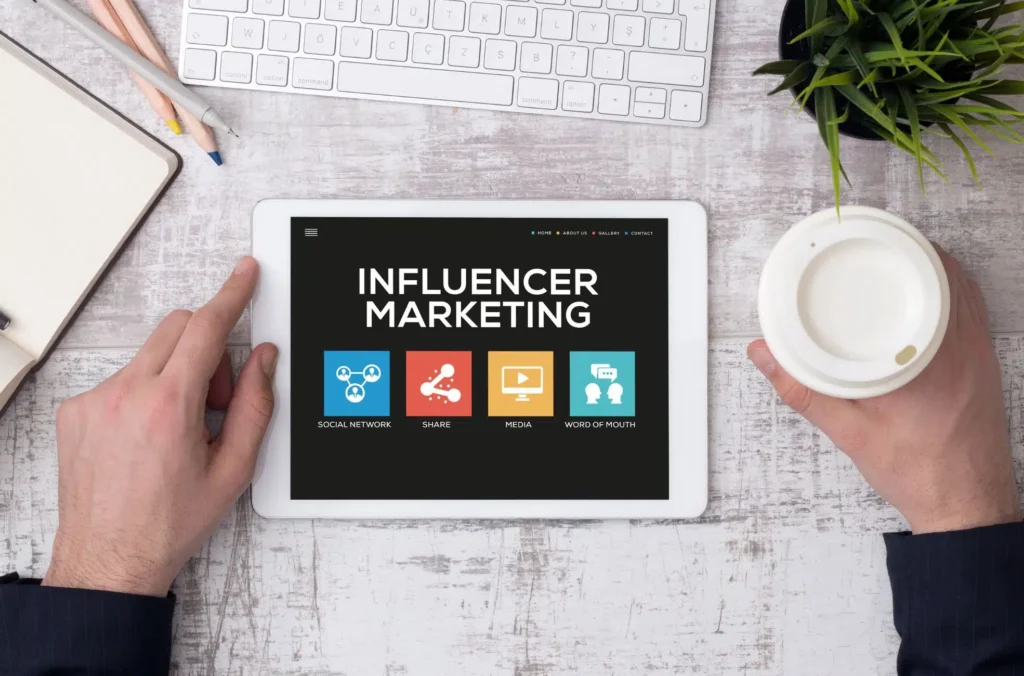Home > Business Success and Challenges > How to Build an Effective Influencer Marketing Strategy for Your Business
How to Build an Effective Influencer Marketing Strategy for Your Business
May 12, 2024 | Business Success and Challenges

In today’s digital marketing landscape, influencer marketing has emerged as a powerful tool for brands seeking to engage with their audience through influential online personalities. Developing a strategy that leverages this trend can significantly boost your brand’s visibility and credibility. However, creating a successful influencer marketing strategy involves a deep understanding of your business goals, the influencer ecosystem, and the complexities of campaign management.
In this guide, we’ll outline the steps to align your marketing objectives with the influential reach of content creators, helping you connect with the right voices and measure success effectively.
You’ll explore the potential benefits of influencer partnerships and learn how to leverage their influence to propel your business forward.
The Rise of Influencer Marketing
What Is Influencer Marketing?
Influencer marketing is a contemporary approach where brands connect with their target audiences through endorsements from individuals with substantial social media followings. These influencers hold sway over their followers’ purchasing decisions due to their credibility, expertise, or established rapport with their audience.
Initially informal, influencer marketing has evolved into a structured industry, with the US Federal Trade Commission implementing guidelines as early as 2009 to promote transparency in these partnerships.
What Is the Success Rate of Influencer Marketing?
The success of influencer marketing is evident in its impressive return on investment. The industry was valued at approximately $24 billion in 2024.
According to the Sprinklr Platform, brands utilizing influencer collaborations experience 4.7 times higher engagement rates for influencer-generated content compared to non-influencer content.
Furthermore, storytelling-focused campaigns have been shown to boost conversions by up to 30%. These statistics highlight the effectiveness of influencer marketing and its significant impact on modern marketing.
Different Types of Influencers by Reach
Influencers are categorized based on their follower count:
- Nano Influencers: Fewer than 10,000 followers, often known for higher engagement rates and relatability.
- Micro Influencers: Between 10,000 and 50,000 followers, known for intimate interactions with their audience.
- Medium Influencers: Up to 100,000 followers, offering a balance between reach and personal connection.
- Macro Influencers: More than 500,000 followers, providing a broader reach.
- Mega Influencers: Over a million followers, known for their extensive reach and celebrity-like status.
Each category brings unique advantages, from high engagement rates among Nano and Micro influencers to the extensive reach of Mega influencers.
Influencer Marketing vs. Traditional Marketing
Influencer marketing differs from traditional celebrity endorsements, offering more measurable returns. While both methods leverage individuals’ fame, influencer marketing provides clearer metrics through social media engagement, such as likes, shares, and comments. This allows brands to better assess the impact of their campaigns compared to the less transparent effects of traditional celebrity endorsements.
The influencer marketing industry was valued at $21.1 billion in 2023. The rise of social media platforms like Instagram, YouTube, and TikTok, combined with the shift towards digital shopping accelerated by the COVID-19 pandemic, has solidified influencers’ roles in guiding consumer behavior. A significant portion of consumers now make purchasing decisions based on influencer recommendations.
This strategy’s adaptability and measurable outcomes make it a powerful marketing tool. Beyond collaborating with human influencers, brands are also exploring virtual influencers—digital avatars that offer creative control and enhanced brand safety. Virtual influencers are gaining traction, complementing real-life influencers and attracting large followings.
Influencer marketing is not just for large brands; smaller businesses can also leverage these strategies to engage meaningfully with their audience. With growing skepticism towards traditional advertising, influencer marketing offers a way for brands to build trust and strengthen consumer relationships. Embracing influencer marketing, including innovative uses of virtual influencers, may provide a competitive edge in the evolving digital marketplace.

Setting Objectives and Goals
Establishing Clear Marketing Objectives
A successful influencer marketing strategy begins with well-defined marketing objectives. These objectives shape every aspect of the campaign, including influencer selection, message formulation, and promotional tactics. Clear objectives provide internal cohesion and ensure that influencers understand their roles, which enhances the chances of a successful partnership.
Setting Achievable and Measurable Goals
Once you’ve established your marketing objectives, the next step is to set specific, attainable, and measurable goals. These benchmarks allow you to track progress and evaluate the campaign’s effectiveness.
Quantifiable goals help you assess success in concrete terms. Metrics such as increased followers, higher website traffic, or sales growth within a set period are examples of measurable outcomes. This evaluation not only determines the campaign’s success but also informs future marketing strategies, enabling continual refinement and improvement.
Aligning Goals With Overall Business Strategy
It’s essential for influencer marketing efforts to align with your company’s broader strategy. This alignment ensures that the campaign supports overarching business objectives, whether it’s entering new markets, strengthening brand presence, or launching new products.
When campaign goals are in sync with the company’s strategic aims, they enhance and complement other marketing initiatives, leading to a more integrated and effective approach.
Example Objectives for Influencer Campaigns
Influencer campaign objectives can vary widely, depending on your goals. Here are some examples:
Brand Visibility: Partnering with influencers who have a large and engaged audience can increase brand awareness. Influencers can introduce your brand to their followers through sponsored posts, leveraging their credibility to enhance brand recognition.
Traffic Generation: Influencers can create content with trackable links or participate in guest blogging to drive traffic to your website. Organizing contests or sweepstakes that require site visits can also effectively boost visitor numbers.
Sales and Conversions: Influencers can play a crucial role in driving sales by authentically showcasing your products or services. Exclusive offers or affiliate programs promoted by influencers can encourage their followers to make purchases. Limited-time offers or product launches can create urgency and stimulate sales.
Customer Engagement: Influencers with specialized expertise and a loyal audience can significantly enhance customer interaction. They can initiate meaningful conversations and build a community around your brand through activities like interactive Q&As or surveys.
User-Generated Content: Challenges and campaigns that encourage followers to create content can increase engagement and provide authentic endorsements of your products or services. This approach helps in building a more relatable and engaging brand presence.
By carefully setting goals and ensuring they align with your overall business strategy, you can create influencer partnerships and campaigns that not only achieve immediate objectives but also contribute to long-term success and a strong connection with your target audience.

Identifying and Choosing the Right Influencers
Criteria for Selecting Influencers
Choosing the right influencers is crucial for the success of your campaign. It’s important to partner with individuals whose followers align with your target audience. Consider the following criteria:
- Audience Demographics: Ensure the influencer’s followers match your target customer profile. Analyze their audience’s age, gender, location, and interests.
- Engagement with Hashtags and Brands: Examine the hashtags the influencer uses and other brands they promote to ensure compatibility with your brand’s values and image.
Tools and Platforms for Finding Influencers
Utilizing specialized platforms can simplify the process of finding suitable influencers. Some notable tools include:
- Upfluence: Offers real-time analytics and performance tracking, allowing you to assess the effectiveness of potential influencers.
- AspireIQ: Focuses on relationship-building and managing influencer collaborations, with features tailored to facilitate smooth partnerships.
- Influencity: Provides advanced AI-driven analytics to help refine your influencer selection process.
When selecting a platform, consider factors such as usability, cost, and whether the features align with your campaign objectives.
Assessing Influencer Engagement and Fit
An influencer’s engagement rate—calculated by analyzing their post interactions—is a key metric for understanding how well their content resonates with their audience. Ensure that the influencer’s values and content style align with your brand to maximize the effectiveness of your campaign.
Approaching and Partnering with Influencers
Treat influencers as valuable business partners. Evaluate their reliability, integrity, and the strength of their network to extend your campaign’s reach. Before proposing a partnership, engage with their content and understand their brand. When initiating contact, clearly outline the partnership terms and allow influencers the creative freedom to produce authentic content that resonates with their audience while aligning with your brand’s message.
Creating Compelling Campaigns
Collaborating on Content Creation
The success of a campaign relies on effective collaboration between your brand and influencers. For example, if a cookbook author and a Michelin Award-winning chef promote your brand’s outdoor entertaining products, their shared commitment to the brand can enhance the campaign’s impact.
To achieve similar results, establish genuine partnerships with influencers. This involves open communication and a thorough onboarding process that integrates influencers into your brand’s culture and objectives. Granting influencers creative freedom ensures they produce content that authentically resonates with their audience. Provide detailed briefs to guide them, but allow them to shape the narrative to maintain authenticity.
Campaign Themes and Messages
Your campaign’s foundation is built on its objectives, which guide influencers and set performance benchmarks. Align campaign themes and messages with your brand’s core values to foster trust and appeal to the influencer’s followers. Incentivize influencers by linking their rewards to the campaign’s objectives, motivating them to deliver outstanding results.
Compliance and Disclosure Guidelines
The FTC mandates transparency in influencer marketing, requiring the disclosure of any material connections between influencers and brands. Non-compliance can lead to legal issues and damage reputations. Ensure that influencers are aware of these regulations and instruct them on how to disclose partnerships appropriately to maintain transparency.
Monitoring and Managing Campaign Progress
Evaluating campaign effectiveness is crucial for refining your strategy. Track metrics such as engagement and conversions to identify successful elements and areas for improvement. Tools like impact.com/creator provide detailed performance data, aiding in resource allocation and strategy adjustment. Keep influencers informed of these metrics to enable them to adjust their content strategies for maximum impact, fostering a collaborative environment for campaign optimization.

Measuring Success and ROI
Key Performance Indicators (KPIs) for Influencer Campaigns
To gauge the effectiveness of your influencer marketing efforts, it’s crucial to establish KPIs aligned with your campaign objectives. Key metrics to track include:
- Impressions: The total number of times your content is displayed.
- Post Reach: The extent of your content’s visibility among unique users.
- Engagement: Interaction metrics such as likes, comments, and shares.
- Follower Growth: Changes in your follower count resulting from the campaign.
- Conversion Rates: The rate at which campaign interactions lead to desired actions, such as purchases or sign-ups.
Additionally, evaluating the nature and sentiment of interactions in comments can provide insights into brand perception.
Tools and Methods for Tracking Performance
Several tools and methods can help you monitor and analyze the performance of your influencer campaigns:
- Social Media Analytics: Most social platforms offer built-in analytics to track engagement and reach.
- Tracking Links and Promotional Codes: Unique links and codes can help trace conversions and sales directly linked to the campaign.
- Influencer Marketing Platforms: Many platforms come with integrated analytics for detailed performance insights.
- UTM Parameters: Adding UTM parameters to URLs helps track the origin of web traffic and user actions.
Analyzing and Interpreting Results
Once data is collected, analyzing and interpreting the results is essential to understanding your campaign’s impact. High impressions alone don’t guarantee success; engagement levels and conversion rates are critical for evaluating effectiveness.
Consider various factors when analyzing results, such as:
- Timing: The impact of when the campaign was run.
- Platform: The effectiveness of different social media platforms.
- Audience Demographics: How well the influencer’s audience aligns with your target market.
Adjusting Strategy Based on Insights
Use the insights gained to refine your influencer marketing strategy. Focus on content and influencers that perform well and consider modifying or discontinuing less effective tactics.
Adopting a continuous learning approach from each campaign allows for strategy refinement and ensures that your influencer marketing efforts contribute positively to your financial outcomes.
Crafting Your Influencer Marketing Mastery
Embarking on influencer marketing is a dynamic process that blends creativity with strategic planning. Success relies on setting clear goals, selecting the right influencers, and fostering genuine collaborations that resonate with your target audience.
By rigorously tracking progress and analyzing results, you ensure that each step of your campaign is informed and purposeful. The influencer marketing landscape is ever-evolving, so remain adaptable, learn from each campaign, and continuously refine your strategy for sustained success.
Harness the power of influencer marketing to elevate your brand and connect meaningfully with your audience. Embrace the journey and let influential voices propel your brand to new heights.
Recent Post




The Ultimate E-Commerce Business Plan Template With Examples

How to Build an Effective Influencer Marketing Strategy for Your Business

